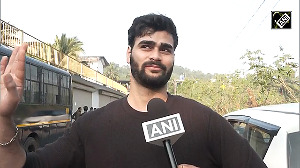 Intending to check cyber attacks on government websites in the country, the Centre was evolving a National Cyber Authority to lay down policies for Indian cyber world, a top DRDO official said in Chennai on Monday.
Intending to check cyber attacks on government websites in the country, the Centre was evolving a National Cyber Authority to lay down policies for Indian cyber world, a top DRDO official said in Chennai on Monday.
Click HERE for more defence news
"We need to integrate the various cyber efforts across the country. There is a plan going on to set up a cyber authority -- National Cyber Authority. But, that is still at evolution stage," DRDO Director General Avinash Chander said.
"It would lay down policies and the methodology and then individual elements in the structure and actual execution would be planned," he told reporters at DRDO's Combat Vehicles Research and Development Establishment lab in Chennai.
Observing that cyber warfare has become a concern, he said "Malwares were getting into the system and corrupting it. Second was disruption of our communication signals. Another was attack on our economic. All these challenges have to be handled in a holistic manner. One way was that we have to slowly ensure that all the critical infrastructure was trustworthy."
DRDO was also working on the country's own routers and security systems so that it can mitigate the cyber threats.
He termed social media as yet another "challenge" to the country, as its was witnessed in Arab revolution, orange revolution and many others. "There also it is important that we are able to control such inherent threats or internal threats. We should be able to isolate the threat from mixing with others."
Replying to a query on the developing of Main Battle Tank Arjun Mark II, he said, "We have some problem with the missiles. All other aspects are fully cleared. We are trying to see what can be the best solution among the available options."
Speaking about the designing future battle tanks, Chander said that people are talking about four-man crew, three-man crew, but the world is changing.
"Automation levels today were different from what was there earlier. By end of this decade, we want to have an unmanned tank or at least which can move along with the soldier," the Scientific Advisor to Union Defence Minister said.
In the unmanned vehicle and systems, he said, UAV Rustom II was to go for flight trials with full configuration in the end of this year.
"We have developed an unmanned underwater system, which can go upto 400 metre depth and the Navy was quite enthused with it for removing mines, mapping, surveying. We are working with navy on what size will be best suitable to be fitted in the ships," he said.
In the 12th five year plan, DRDO was going to take up a gun programme under armaments cluster. "We are also taking surface to air missiles -- short range, long range -- as part of this plan. We are also going to induct long range Agni V and Agni IV systems into the weapons. We will work on the manoeuvring systems in the future. In the next three years, we are going to design an anti-tank guided missile of a shorter range."
DRDO scientists were also working on high altitude radars as well as the electronically scanned radars, which are going to fly in the LCA. "We are also going to make electro optic systems, electronic warfare system, which are going to get inducted in the ships by 2015-16."
Asked why was the DRDO not giving opportunities to the private companies in defence production instead of PSUs, the Defence Secretary (R&D) said, "what it requires is some kind of a policy drive legislation change. Today, explosives are totally handled under the government control."
"Definitely, I think, the time has come when we have to look for changes in our policy how to harness the national capability towards Defence's efforts. I am sure this is a running question, which the government should be addressing in the coming period," he said.
The canister-based test for Agni V in the second half of this year.
To a query on the erosion around Wheeler Island, off Odisha coast, the Union Defence Ministry's only facility to test missiles, was "being stabilised and not much of erosion in the last few months."









